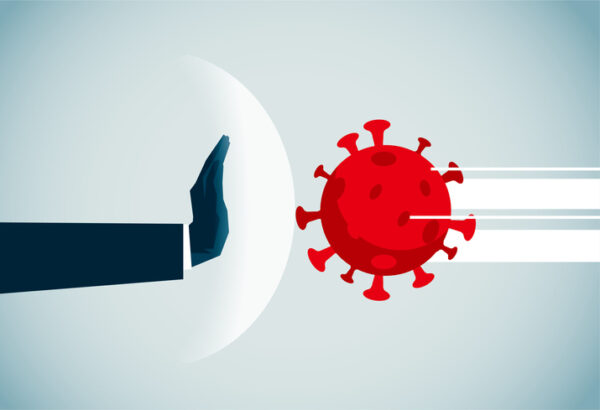
commercial illustrator
The bar is rising for Covid-19 vaccines.
Moderna said today that interim results for its vaccine candidate show an efficacy rate of 94.5%, exceeding the 90% efficacy rate announced a week ago by Pfizer and its partner, BioNTech. The company also revealed data suggesting the vaccine can be stored at not-so-chilly temperatures, potentially smoothing out distribution challenges.
But as with Pfizer and BioNTech, the news came via press release. The results of Moderna’s Phase III trial have not been peer-reviewed.
Still, the news comes as another positive development in the fight against Covid-19, which is spreading uncontrolled throughout the U.S. More than 1 million Americans have contracted the virus in just the last week, pushing total cases close to 11 million, according to the Centers for Disease Control and Prevention.
“This is a pivotal moment in the development of our COVID-19 vaccine candidate,” Stephane Bancel, CEO of Cambridge, Massachusetts-based Moderna, said in a statement. “Since early January, we have chased this virus with the intent to protect as many people around the world as possible.
The Moderna vaccine, dubbed mRNA-1273, relies on a similar mechanism as the Pfizer/BioNTech candidate. Both are based on messenger RNA, which is supposed to prompt an immune response to the virus.
Moderna’s Phase III study includes more than 30,000 participants in the U.S. The interim efficacy results – certified by the Data Safety Monitoring Board, a panel appointed by the National Institutes of Health – are based on 95 cases of Covid-19, with 90 coming from those given a placebo. The analysis also is based on 11 severe cases of Covid-19, all of which surfaced in the placebo group.
“This positive interim analysis from our Phase 3 study has given us the first clinical validation that our vaccine can prevent COVID-19 disease, including severe disease,” Bancel said in his statement.
Some volunteers reported fatigue, headaches, injection-site pain and other mild-to-moderate reactions to the two-dose vaccine. Some reactions were severe, though short-lived. Preliminary analysis suggests the vaccine is safe, Moderna said.
Safety concerns have led to pauses in trials for other vaccines. The Food and Drug Administration has said it wants about two months of safety data before granting emergency use authorization to a vaccine.
In addition, Moderna said its vaccine can remain stable for 30 days at temperatures between 2 degrees and 8 degrees Celsius. That’s roughly the temperature of a standard home or medical refrigerator, Moderna said, making the vaccine potentially easier to distribute. Longer-term storage requires temperatures of -20 degrees Celsius.
The Pfizer vaccine must be stored at temperatures near -80 degrees Celsius.
Based on the results so far, Moderna hopes to emergency use authorization within weeks. If all goes as planned, the company expects to roll out roughly 20 million doses of the vaccine by the end of 2020.
All told, the U.S. will need at least 250 million doses to achieve so-called “herd immunity,” according to Summer Johnson McGee, dean of the school of health sciences at New Haven University in West Haven, Connecticut.
“Just tens of millions of doses will be available by the end of the year so we should expect that a mass vaccination program should take at least six to nine months from now to achieve widespread vaccination in the U.S.,” McGee wrote in an email response to questions.
Once health care workers and vulnerable populations are immunized, she said, the next round should go to prisoners, college students and others who live in group settings.
“Vaccinating K-12 students and teachers will allow students to return to school, which is a key component of allowing parents to work and keeping our economy going,” she wrote
McGee expected it would take a “massive public education campaign,” as well as transparency and data sharing, to convince the public to get vaccinated.
“While we have developed these vaccines quickly and that may cause some skepticism, the technology these vaccines are developed upon has been thoroughly vetted by the scientific community,” she wrote. “We need to regain our trust in science and scientists if we are to see widespread participation in our vaccination plan.”
Other vaccine candidates, meanwhile, are moving through the clinical process.
On Monday, Inovio Pharmaceuticals said it has been cleared by the FDA to start the Phase II segment of its Phase II/III trials for its vaccine candidate, called INO-4800. Like the others, INO-4800 involves two doses.
The Phase 3 trial is on hold due to regulatory questions about the device used to deliver the vaccine, according to Inovio, which is based in Plymouth Meeting, Pennsylvania. The company hopes to resolve those questions during Phase 2.
Also headed for Phase II/III trials is a vaccine being developed by Medicago and GlaxoSmithKline. The two companies announced last week that they had gotten a green light from Canadian regulators. Medicago is a biopharma company based in Quebec City. GSK is based in London.
The Phase II study will take place at sites in Canada and, if the FDA approves, the U.S., the companies said. Phase III is expected to begin by the end of 2020 with more than 30,000 participants in North America, Latin America and Europe.
Photo: erhui1979, Getty Images








